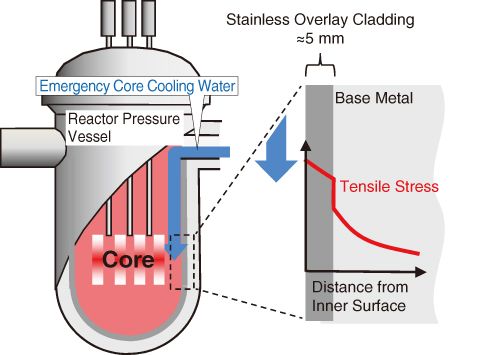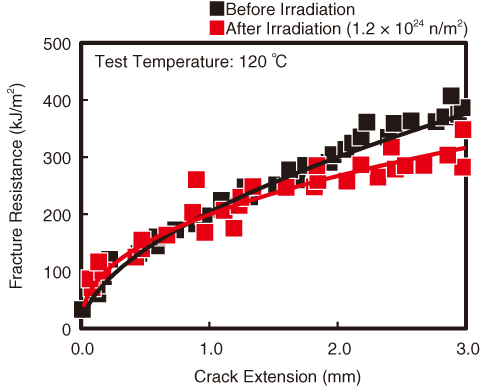
Fig.2-5 RPV and PTS event

Fig.2-6 Fracture resistance curves of stainless overlay cladding
The reactor pressure vessel (RPV) is the most important component for safe operation of a nuclear power plant. Pressurized thermal shock (PTS) is one of the most severe events that may lead to the failure of the pressurized water reactor (PWR). PTS is a transient event caused by rapid cooling of the inner surface of the RPV, which is consequently due to the injection of emergency core-cooling water. PTS causes high tensile stress on the inner surface of the RPV (Fig.2-5). Assessing the structural integrity of the RPV during a PTS event postulates the formation of an axial semi-elliptical crack on the inner surface of the RPV base metal or weld metal. To prevent the corrosive effects of the reactor coolant, the inner surface of a RPV is overlaid with cladding made of 5-mm-thick austenitic stainless steel. A PTS event may lead to higher tensile stress in the cladding region. Understanding the properties of fractures in cladding materials that have been irradiated by neutrons is necessary to improve the assessment of the structural integrity of a RPV.
We tested the elastic-plastic fracture toughness of cladding materials subjected to a neutron fluence of 1.2 × 1024 n/m2. Typical fracture resistance curves for cladding materials before and after irradiation are shown in Fig.2-6. The test temperature of 120 ℃ is the temperature range in which tensile stress increases during a PTS event. As shown in the figure, the fracture resistance of cladding materials increases as the crack extension proceeds. No obvious degradation appears in the fracture resistance curves of the cladding materials after neutron irradiation. These properties are similar to what is found at other temperatures, and no brittle fracture appears in the low-temperature region. These results suggest that the fracture properties of the cladding region change little over the long-term operation of a RPV.
This study provides data on the materials’ properties that will improve the assessment of structural integrity and contribute to the preparation by academic societies of the requisite standards.